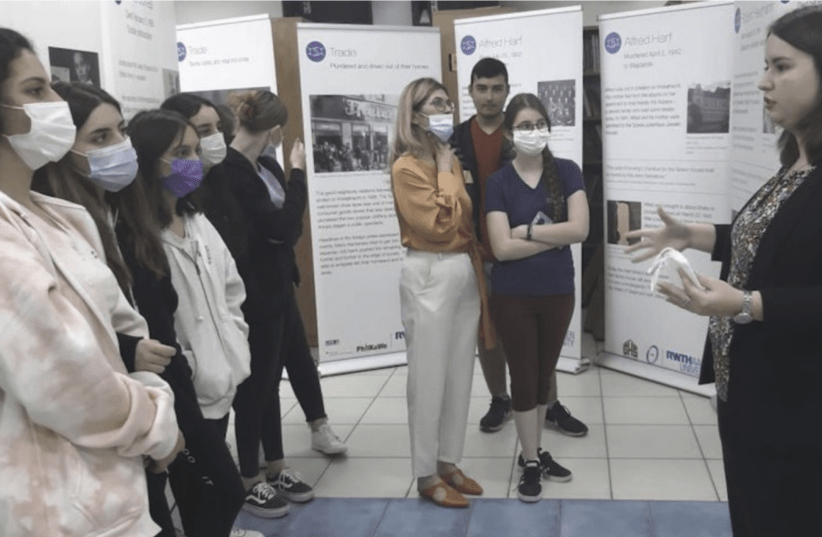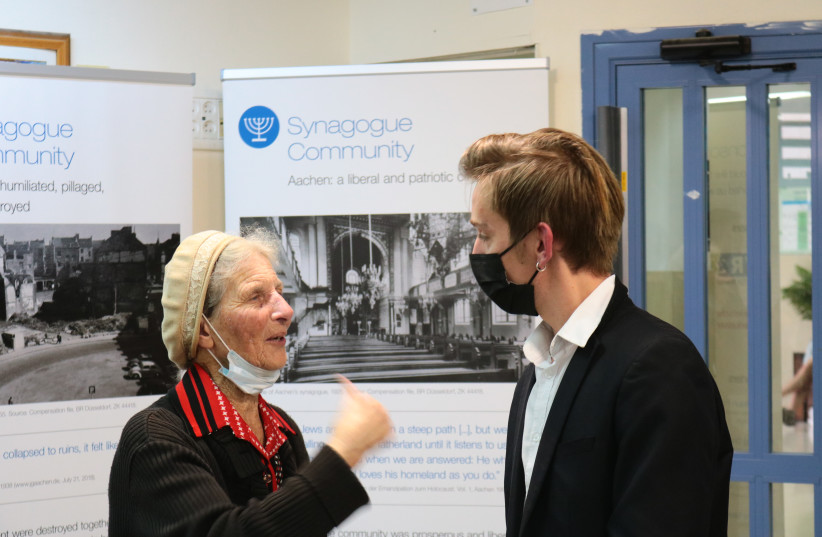‘Does anyone know why our project is called ‘We, the Six Million’?” Alexander Hermert asks the assembled students. At first, no one answers. “It stands for the six million Jews killed in the Holocaust,” one pupil answers after a moment’s hesitation. Hermert nods.
As part of the project “We, the Six Million,” Hermert came to Israel together with his colleague Janine Gielis, to introduce the topic to students. The project is being carried out by RWTH Aachen University, is sponsored by the Office of the State North Rhine-Westphalia for Buisness, Science, Educational, Youth and Culture in Israel and supervised by the Society for Christian-Jewish Cooperation Mönchengladbach. Hermert and Gielis presented the project’s exhibition at Yeshivat AMIT Amichai School in Rehovot.
“The problem is that in schools, when it comes to Holocaust education, it is always factual, with lots of numbers. What gets lost is that ‘six million’ is not just a number. They are lives, dreams that were taken,” says Hermert.
The “We, the Six Million” project had been given access to the compensation files that were collected after the war; the Federal Republic of Germany used these detailed files to compensate Jewish survivors. Those working on the project from the Aachen area in North Rhine-Westphalia were able to collect many biographies, and conducted extensive interviews with victims’ relatives and survivors. The biographies were then published.
“It was impressive to look into these files, to go very deep into the lives of these people, and to find out very personal things. It gave us a different perspective,” Hermert continues.
“We wanted to share this experience with younger people, and it became the exhibition you see today,” he said. “We chose biographies where we could get a vivid idea of people. We want to create an emphatic moment, to get into the individual destinies.”
For many Jews interviewed for the project, the 1938 Kristallnacht “Night of Broken Glass,” was a traumatic experience. To bring home the point, the project introduces each person on two rollup displays to convey a “before and after” effect.
“On the first one, the person is introduced. Where do they come from, what is their background, what are their wishes, dreams? It always ends with Kristallnacht. That is the break,” Hermert says.
The second exhibit deals with the lives of the persecuted Jews after the Third Reich. “What happened to them afterward the war is forgotten.”
The project, originally undertaken by German schools, culminated in the exhibition’s first premiere in Aachen in 2019, on the anniversary of Kristallnacht. “It is important for us to create an empathic element. Pupils from Aachen know these sites where the Jewish families lived at that time. They have an emphatic moment right away. It is not abstract and far away, but right around the corner in their hometown,” Hermert notes.
It was then suggested that the project should be shown in Israeli schools, which Hermert says has been a great honor. The project has taken on a personal meaning for him as well, as he points to one of the displays that describes the fate of a Jewish family from Aachen. “This family standing in the front – the Dahl family – are our hosts in Israel.”
The project has several categories: Aachen’s urban and rural communities; the textile industry, which was the economic backbone of the city for centuries; trade, one of very few areas in which Jewish entrepreneurs were significantly represented; craftsmen, as well as Jews involved in academia. Rural Jewry in and around the Aachen area “came out of the shadows” through the cloth trade before the time of the Third Reich, Hermert notes.
The biographies of the Jews described are divided into social groups. “We wanted to show that the Jewish community is very diverse. A Jewish professor had a different fate during the pogroms than a Jewish craftsman. The social background is crucial.”
HOW HAS the project been received? How do Israeli and German pupils react to the project, to the fates of the people? “Aachen is not known in Israel. So we were unsure how the project would be received by the students,” Gielis observes. “We were positively surprised by how well the pupils accepted the project.”
There were countless questions at the first school, where the project premiered in Israel – especially about Germany and German Jewry itself. “Everyone is familiar with what happened in 1938, but the other dates are not so known,” Gielis says as she points to the timeline.
“January 30, 1933 – Adolf Hitler becomes Reich Chancellor,” is the first defining date. “This is followed by the boycott of Jewish businesses on April 1, 1933, the Law for the Restoration of the Professional Civil Service on April 7, 1933, which excluded Jewish civil servants from the civil service.
“Because these dates are so important for context, we always start with them. Then we talk about the files that were sifted through for the project. And we have to explain where Aachen is in the first place,” Gielis adds with a smile.
When asked how Israeli students relate to Germany today, Gielis replies: “It varies greatly. A lot depends on whether they, or their parents, have traveled a lot. Many have already been to Berlin and talk very positively about Germany; they are even very enthusiastic.”
Other students have never been to Europe or Germany. Sometimes there was a little fear. “They say their grandfather or great-grandfather lived during the Holocaust, and that’s why they have prejudices,” she says. “But other students who have been there react immediately. They say that there is nothing to be afraid of, and talk about their own experiences. That’s the nice thing – that such lively discussions arise within the framework of our project.”
Special worksheets prepared by Gielis and Hermert allow students to express their impressions of the project. After a short introduction, the pupils read through one or two biographies, then describe their emotions as well as their own questions.
“Then there is another round of reflection, where the questions are quite different. They ask questions about people, about Germany, about the situation in Western Europe,” Gielis says. “We talk to a lot of students who are in diplomacy classes, who are very interested in international relations and world politics. With them, we can have good discussions about antisemitism.”
A sister project by students from the AMIT Amichai School is proof that the project has been well received. The 11th grade students were given names and contact details of Holocaust survivors in Rehovot, whom the students then interviewed. They created their own exhibition, complete with posters, digital presentations of the stories, and an impressive 17-minute video in which survivors talk about their experiences.
Translating the interviews also enabled the students to polish their English-language skills. For the Israeli students, it was an opportunity to transform the subject from an academic subject to be studied in school, to a personalized encounter with the Holocaust.
The writer is an International Journalist’s Programs fellow from Germany. He works for the online editorial department of the “Frankfurter Rundschau,” and covers Germany, European politics and the Middle East.


